Boeing B-17 Flying Fortress, Co. Sligo, December 1942
The build up of the United States Army Air Forces in the United Kingdom would result in a flurry of foreign aircraft incidents in neutral Ireland during the winter of 1942 and 1943. The first such American aircraft had landed in July 1942 at Rinneanna aerodrome, Co. Clare. Four more aircraft would arrive on Ireland's soil, or as was the case, its sand, during December 1942 with two more in January 1943.
The first of these winter arrivals occurred on the 5th of
December 1942 when a large four engine bomber landed on a beach
at Mullaghmore, in the county of Sligo at around 4.30 pm.
The crew were met on the night of the landing by Captain Joseph
Birthistle, the Irish Army, Western Command Intelligence
Officer. His expenses report from months later provides a
view of the events in the immediate few hours after the landing.
At 02.00 hours on the morning of
December, 6th after returning from securing Fortress in the
storm the crew of five had coffee and biscuits with me at
the Hamilton.
On 6th the crew were joined by three ground Engineers
from Northern Ireland, 1 Truck driver and one Liaison
Officer,. F/L Heaton. They remained on the beach all day in
the hope of taking off but as the storm did not abate the
take off was abandoned. At 19.30 hrs. we had a mixed grill
at the Red House Hotel.
10 Mixed grills
Liquid Refreshments
On 7th they worked on the plane all day but one engine
gave out. I received instruction for the transfer
of the crew and the only meal that day was dinner at
19.30 hours before the crew were disposed of.
10 Dinners (Hamilton Hotel)
Phone calls.
The story was told from the point of view of the co-pilot Jack
Rolfson in the August 2005 newsletter for his veterans
association, the Hell's Angels Newsletter of the 303rd
Bombardment Group (Heavy).
The reason for their flight from their base at Molesworth,
Cambridgeshire was given by Rolfson to Frank Mangan in 2005:
On December 4, 1942, Major Charles
Sheridan, commanding officer of the 303m Bomb Groupís 427th
Squadron, ordered Ralph Hayes and his crew on a secret
mission.
They were to fly their B-17 to Northern Ireland to meet a
P-38 Fighter Group and then fly on with the fighters,
running fuel consumption tests, to a Casablanca base in
North Africa. The mission was postponed a day due to poor
weather. The next day they were ordered to take off at 12:30
even though the weather conditions were again unacceptable.
Co-pilot Jack Rolfson and Ralph were aboard the plane along
with their navigator, Frederick IlIgen, engineer Antoni
Bednarchuk, and radio operator, Jesse Jessee.
The fact that the flight was canceled on the 4th due to
inclement weather but was forced off the ground with more
poor weather on the 5th is somewhat of an anomaly. One
assumption was that the P-38s could not wait any longer for
the fuel test run to North Africa.
The crews situation in The Devil Himself proved to be
difficult. On leaving England, Illgen was given codes to
turn on a radio beacon at Eglinton airfield in Londonderry,
Northern Ireland. The problem was that the codes were
incorrect.
The plane had been ordered out of Molesworth without a
clear backup if problems arose before landing in Eglinton.
There was only enough daylight for a one-way trip at that
time of the day. There was no point in trying to return to
Molesworth in the dark because lllgen was not given the
codes to activate any landing beacons in England.
There then followed an epic 17 day repair effort described in Frank Mangan's article linked above.
Repaired, the aircraft was finally able to depart on December
22nd. On the 4th of January 1943, Captain M
Cumisky, Acting Adjutant, The Air Corps, filed a report, dated
incorrectly, 4th January 1942 which summarised the events of the
previous weeks.
Forced Landing of Fying Fortress at
Mullagmore Strand, Co. Sligo on the 5/12/42.
Sir,
I have the honour to append report in connection with
forced landing of above mentioned aircraft.
Type of Aircraft American
Boeing Flying Fortress long range bomber. It was
fitted with 4 Wright cyclones R.1820 - 69
engines.
Service Markings 124612 R.
Armament
Nose - 2 x 0.5 M.Gs separately
hand operated
Top - 2 x 0.5 M.Gs in
turret
Belly - 2 x 0.5 M.Gs in turret
Waist - 2 x 0.5 M.Gs separately hand
operated
Tail - 2 x 0.5 M.Gs in
double mounting, hand operated,
Top - 1 x 0.5 M.Gs operated
in emergency from Radio compartment.
Special Equipment
Reflector Gunsight which (as far as could
be ascertained) compensates automatically for the
relative speed of the enemy aircraft when
firing broadside.
Mk. 7 bombsight, parts of this were
missing and its principle of operation could not be
ascertained.
Cause of Forced Landing
Weather conditions over aerodrome to
which aircraft was bound for were unfavourable for
landing and darkness
was approaching.
Mission
Changing station from somewhere in S.E. England to Eglinton,
Northern Ireland.
Conditions
One engine was unserviceable. The
agency supplied a new engine which was fitted to the
aircraft. The aircraft was tested and took off for its
destination at 13.10 hours on the 22/12/42.
What is interesting is that one of the crew members, Antoni Bednarchuk received the Legion of Merit award following the incident, the award being published in the Stars and Stripes forces newspaper.
It later appears in the maintenance records for the Lockheed
Overseas Corporation as undergoing work in the Langford Lodge
facility. It was flown by Hayes and Rolfson for the first
time in combat on February 18th but was forced to abort the
mission due to a waist gunners flying suit electrical cord
becoming severed. It's combat career came to an end on
it's ninth mission on the 19th of May as the mission report
records: The Devil Himself,
#41-24612, piloted by 1Lt. Armand F. Burch, circled
Molesworth for a
landing with the right aileron torn to shreds and the right
tire blown out. Lt. Burch, despite this handicap, kept the
ship under perfect control and came in for a beautiful
landing. His comment was, "They get rougher every time, but
the bombing gets better. Today's were right on the nose."
The aircraft's individual history shows it to have been
transferred to AFSC, believed to be Air Force Service Command,
for 'Special gun tests' on 25th May 1943. Thereafter it
served with the 1 Combat Crew Replacement Center at Bovingdon
before returning to the United States in on the 20 December
1944. It was sold for scraping on the 9 October 1945.
The aircraft, carrying serial number 41-24612, was a Boeing
B-17F-27-BO Flying Fortress. This was an aircraft built at
the Boeing plant in Seattle. It actually appears in a well
known photo taken at the assembly plant at the time of its
delivery.
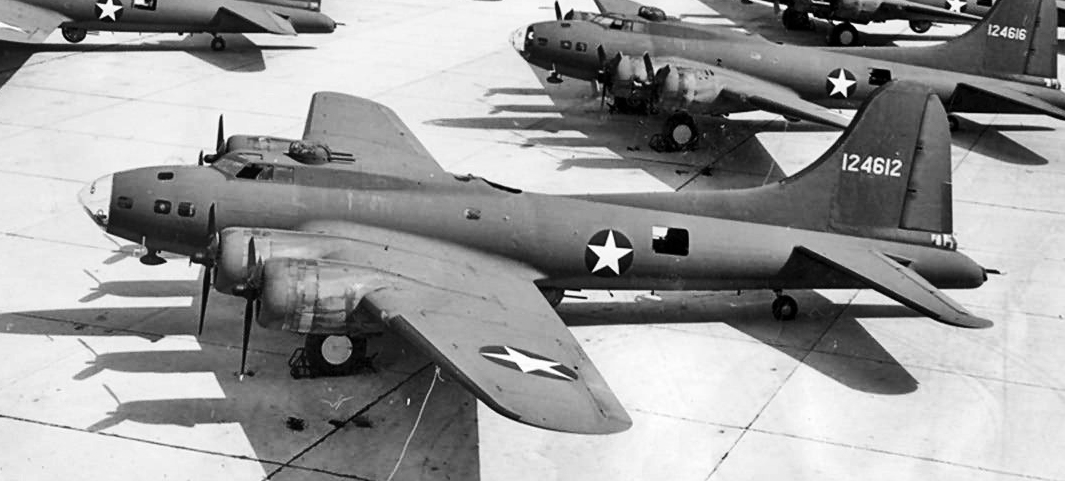
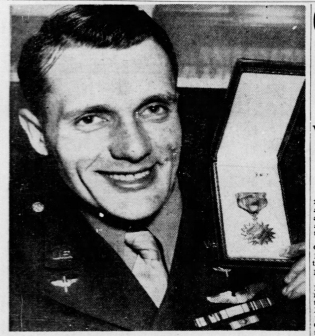 Ralph S Hayes
Jr, O-430583 was born in 1914 in New York to Gertrude and
Ralph Hayes. His mother sadly passed away when Ralph was
just four so he he grew up in Rochester with his grand
mother. The 1940 census finds him apparently at Langley
Field Hospital, Virginia, but his occupation is listed as
'Mechanical Engineer, Automobile' and he doesn't appear to be in
the military at that point. His local newspaper, the Democrat
and Chronicle of Rochester followed his wartime
career. The Star-Gazette from Elmira, New York reported in
October 1941 that he was being sent to the flying school at
Barksdale, Louisiana.
Ralph S Hayes
Jr, O-430583 was born in 1914 in New York to Gertrude and
Ralph Hayes. His mother sadly passed away when Ralph was
just four so he he grew up in Rochester with his grand
mother. The 1940 census finds him apparently at Langley
Field Hospital, Virginia, but his occupation is listed as
'Mechanical Engineer, Automobile' and he doesn't appear to be in
the military at that point. His local newspaper, the Democrat
and Chronicle of Rochester followed his wartime
career. The Star-Gazette from Elmira, New York reported in
October 1941 that he was being sent to the flying school at
Barksdale, Louisiana.
On the 13th December 1941, he and a number of class mates
featured in the Shreveport, Louisiana paper, The Times. A
group photo of five of the men appeared alongside their fiances,
in an article relating how the men had just graduated from
flight training and received their commissions as
officers. He got married on the day the newspaper printed,
to Miss Sally Rogers.
On the 19 of September 1942, Ralph was home visiting his
parents prior to departing for overseas.
He piloted a bomber across the Atlantic in late October 1942
with the bomb group. A fellow pilot, Ehle H Reber, whose
journal is carried on the 303rd Bomb Group website, mentions the
Irish adventure of Ralph S Hayes and his partial crew:
Dec. 9, 1942 Wednesday
We learned that Lt. Hayes and crew, who started on a
flight to Northern Ireland to run some fuel consumption
flights with pursuits, became lost and ended up in Irish
Free State. The Free State is neutral so the crew and plane
is probably interned until such a time that arrangements are
made for their release. Only 8 planes in squadron now. With
his loss, it is doubtful whether he will join us, if and
when he is released. .....
Jan. 5/43 Tuesday
Dull day. Plane should be out of the hangar soon.
Scheduled to fly Billy B's plane on practice bombing
mission, but it was cancelled on account of visibility and
weather in general. The 303rd has now lost 25% of its air
echelon in two months of operational flying. Nine crews and
11 airplanes, including Hayes. However he should be back one
of these days. Rapid turn-over.
Jan. 19/43 Tuesday
All transportation called in. A lot of walking now by
all personnel. Result of accident over the weekend in which
two enlisted men were killed in Jeep. I was suppose to go to
Cambridge this evening, but of course trip cancelled due to
lack of transportation. Weather is very foggy. Jerry Jinx
still loaded with 5 x 1000. Received six letters yesterday
and two today. Morale of men not too good. Lt. Hayes back
soon (?).
2/Lt Reber would be lost on the 23 January 1943 hence he never recorded the return of 2/Lt Hayes to the Squadron.
Ralph S Hayes Jr service with the 303rd Bomb Group is covered
by their website, where he has a dedicated
page. Ralph did not undertake a combat mission until
the 15th February 1943, showing that there was considerable
delay caused by the landing in Ireland. He was posted back
to the USA in August 1943 and appeared then in newspapers
recounting his wartime adventures with an aircraft named the
"The Devil Himself"
He was the commander of the 730th Bomb Squadron of the 452nd
Bomb Group between September 1943 and July 1944. The 303rd
BG website highlights that he was the "Engineering Officer
Aphrodite Project 01 Jul 44" and he is briefly mentioned
in the book Lost Destiny: Joe Kennedy Jr. and the Doomed
WWII Mission to Save London by Alan Axelrod. The
303rd BG Association also link him to being a Technical
Inspector with the 3rd Air Division from 22 Oct 44, then Air
Inspector with 4th CBW/3rd AD on 23 Dec 44. There was in
1944/45 another officer of the same name serving with the 401st
Bomb Group in England. But confusingly, Capt, R S Hayes
O-430583 appears listed as the name of a witness to the loss of
a 401st Bomb Group aircraft in December 1944.
The Geriatric Pilots Association contained an apparent reference to Ralph's flying career: Hayes, Ralph S - AAF Pilot B13, 17, 18, 24), A29, L4B, LB30, AT6, 7, 8, PT13, 17), BT15, C78, Curtiss 02Cl. B17 pilot, special open cockpit B17 modified to accommodate two 16,000 pound depth charges (10 feet by 3 foot diameter), 8th Air Force Europe, 200 hours combat, UK. Colonel
Ralph died in 2011 in Rochester, New York. His obituary
recorded his post war career as: After
the war, Ralph took his Mechanical Engineering knowledge and
incorporated it to many fields in his works with Syracuse
China, Carrier Corp. and Ingersoll Rand. He was plant
manager for Forster mfg Co. in Wilton, Maine. Ralph then
took a position as Design Engineer with Stanadyne Corp in
Chicago. He owned Falls Electric Co. in Syracuse, NY and
WindWinder Corp. in Dayton Ohio. Ralph and his
Brother-in-law, Otmar Ulbing, were instrumental in designing
and filing for several patents.
It also mentioned the landing in Ireland in the following
inaccurate way: He flew B-17ís
during WWII. He even saved his crew after being hit and
losing power by landing on a beach in Ireland.
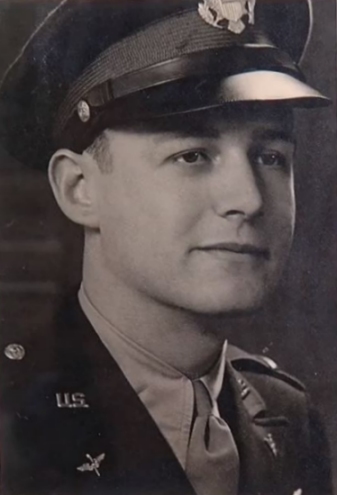 Jack
G Rolfson, O-791053 was the last surviving member of the
partial crew, having passed away in 2017. He was born in
September 1921 to Martha and B H Rolfson in Omaha,
Nebraska. Just some days before his death he had been
interviewed by the WTVC News channel, and that can be seen on
this Youtube video.
Jack
G Rolfson, O-791053 was the last surviving member of the
partial crew, having passed away in 2017. He was born in
September 1921 to Martha and B H Rolfson in Omaha,
Nebraska. Just some days before his death he had been
interviewed by the WTVC News channel, and that can be seen on
this Youtube video.
The Nebraska State Journal of Friday May 9, 1941, along with
many other Nebraska papers carried the following report on
Jack's early entry into the war against Germany:
OMAHA (AP) Jack Rolfson, 19, a freshman
at the University of Omaha, soon will be one of the 10,000
Americans fighting for British and allied forces. The
engineering student will leave this week end to join the
Canadian royal air force for active service as a student
pilot. He is the son of Mr. and Mrs. B. H. Rolfson.
On the 16 of February 1942 he registered for the US Government
draft, stating on the form that he was employed by the Royal
Canadian Air Force.
Following the end of his tour of duty his name is found listed
on the manifest for Douglas C-54 41-37284 arriving into New York
from Prestwick, Scotland on the 10th August 1943.
His name was mentioned in country wide newspapers in July 1943
when the story of the return flight from Hamburg of Lt. William
Leferve's crew.
Frederick J Illgen, O-443073
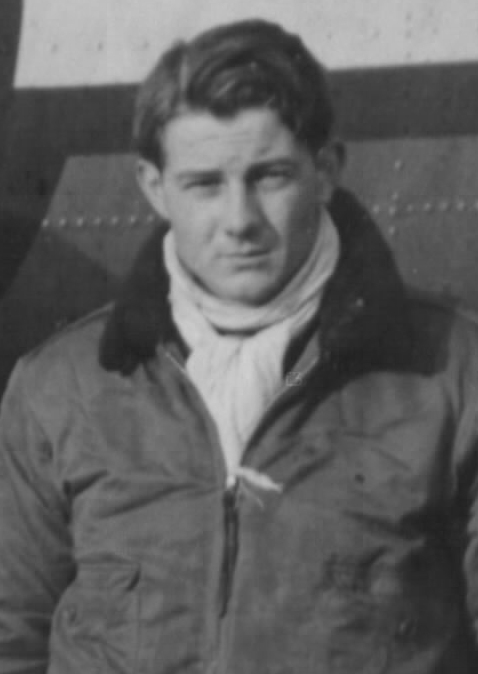 Frederick was
born in Alameda county, California in 1915 to Margaret and
Martin Illgen, one of five siblings born to the German born
couple.
Frederick was
born in Alameda county, California in 1915 to Margaret and
Martin Illgen, one of five siblings born to the German born
couple.
The voters registration for 1940 lists him as a grocery clerk
living at home with his mother and one voting aged sister.
His draft registration record from late 1940 shows him to
be studying at the University of California.
His enlistment into the Air Corps as a cadet is recorded as
being on 29 September 1941 and was directly into the air
corps. his service is recorded on the 303rd Bomb Group
website. He is listed as being present in a number of crew
photos on the website. The photo on this page comes from
one of many he is listed as being in on the Fold3 website.
Frederick passed away in November 2008 in Sacramento.
Antoni Bednarchuk, 11043689
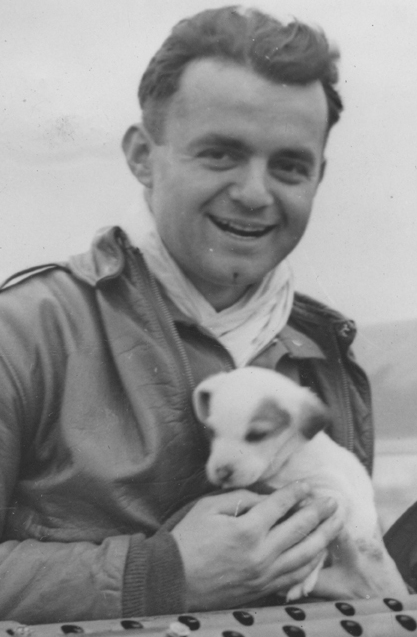 Antoni was born in 1915 in Rhode Island,
the son of emigrants, Mary and John Bednarchuk.
Antoni was born in 1915 in Rhode Island,
the son of emigrants, Mary and John Bednarchuk.
The 1935 state census of Rhode Island finds Antoni learning a
trade at the Providence Trade School and living with his parents
in Woonsocket. At the time of his registration for the
draft in 1940 he was working for the interstate bus
company. The 1940 census shows him working as a farm hand.
He enlisted in January 1942 directly to the Army Air
Corps.
He was awarded a Legion of Merit Award for his engineering
efforts during the repairs to 'The Devil Himself', having his
name published in the Armies' Stars and Stripes publication on
the 8th March 1943.
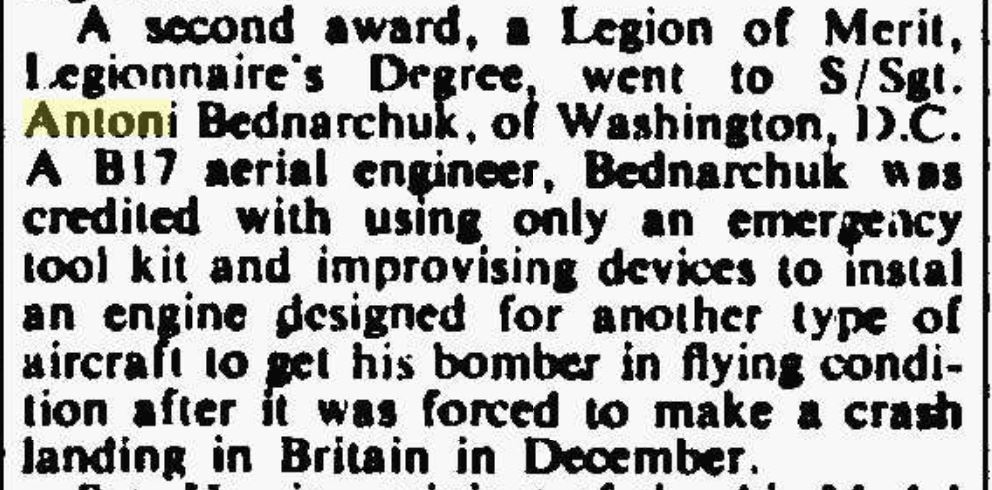
The official Air Force Communique was worded as follows:
Antoni Bednarchuk, 11043689,
staff sergeant, 427th Bombardment Squadron (H), Army Air
Force, United States Army, for outstanding performance of
duty, under extreme difficulties resulting from a crash
landing of a B-17F airplane on 5 September 1942. The
airplane crashed in a remote section of the country,
disabling the No. 4 engine. Transportation facilities were
exceedingly limited; Sergeant Bednarchuk, aerial
engineer, working long and uninterrupted hours with only an
engineer's emergency kit and improvised devices, changed
engines, installing an engine designed for another type of
airplane, placed the craft in flying condition, then acted
as co-pilot on the flight to the base. The efficiency,
energy, and technical skill displayed by this soldier were
of the highest order, are worthy of emulation, and reflect
credit upon himself and the armed forces of the United
States. Address: The Adjutant General, Washington, D. C.
His photo appeared in British newspapers in May of 1943
reporting on his award and showing him with his canine mascot.
Irish newspapers of the time would not have carried any
announcement due to war time censorship.
His award of the Distinguished Flying cross was published in
February 1944.
His mother also was recorded for her war effort in so much as
she is given as an example of how American's at home supported
the war effort and their loved ones. She is used as an
example in a number of books, including American Crucible by
Gary Gerstle. He includes in his book the following about
Mary. Not all the
participants, of course, cared as much about the nation's
official war aims as they did about getting a loved one home
alive. Many, we know, grew perturbed at the endless
appeals to patriotism that always seemed to conclude with a
request for money or sacrifice. Still, the average
American's personal investment in the war, measured in terms
of family members or kin serving in the military and risking
death, made a skeptical, detached attitude towards the
country's war aims difficult to maintain. Mary
Bednarchuk, an aging Polish textile worker in Rhode Island
eagerly awaiting retirement declared that loyalty to her
son, a much decorated aerial gunner, rather than to her
country, made her determined to "keep going until the war is
over". Yet she lavished great attention on her son's
medals and diligently collected newspaper and magazine
clippings describing his heroic acts."
Antoni passed away in 1990 in Rhode Island, survived by his
wife. The 303rd Bomb Group Hells Angels recorded his
passing in the June 1990 issue as follows: Antoni Bednarchuk (427th) died recently in
North Smithfield, RI. A long time member of the
Association, he was also a long time member of the
303rd. In 1942 he attended gunnery school in Las
Vegas, Nevada. He was a tail gunner and finished his
tour of 25 missions which was the quota in the early days of
bombing of Fortress Europe. He received the
Distinguished Flying Cross, legion of Merit award and the
Air Medal. He is survived by his wife Maysie.
Jesse J Jessee 19032392
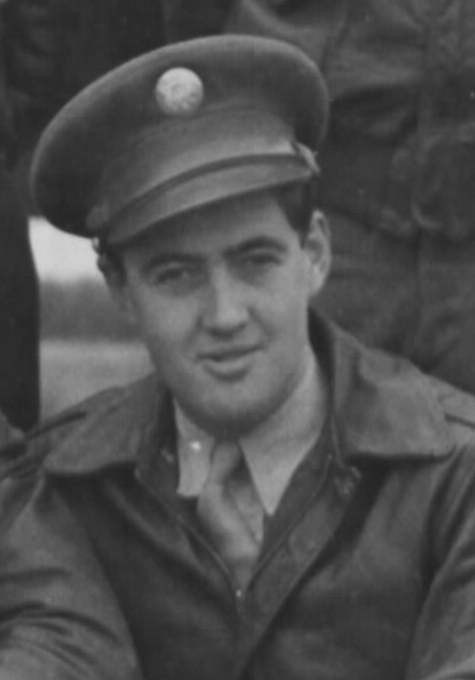 Sgt Jessee
was born in Washington state, in 1921 to Nellie May and William
Homer Jessee.
Sgt Jessee
was born in Washington state, in 1921 to Nellie May and William
Homer Jessee.
He enlisted in the Air Corps in Oct 1940.
He served part of his war time service with the 483rd Bomb
Group's, 840th Bomb Squadron, based on that groups
website. By October 1943, he was posted to the 2900th
Combat Crew Replacement Center at Snettisham Airfield, Norfolk.
A draft registration for him dates from 1945 where his
occupation is listed as "Just discharged from Army". He
was at that time resident in Coeur D'Alene, Idaho.
Jesse died in 1984.
Compiled by Dennis Burke, 2025. Irish Military Archives
Files G2/X/1107 and ACF-S-149.
